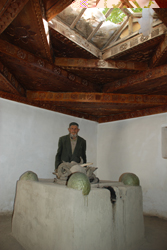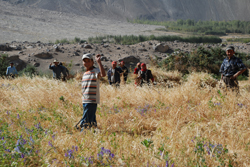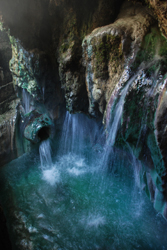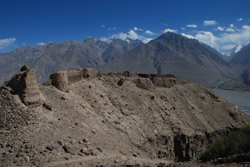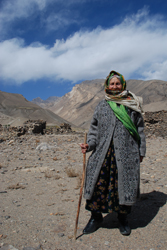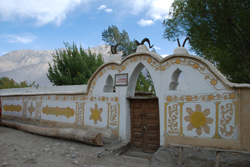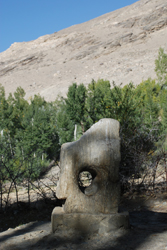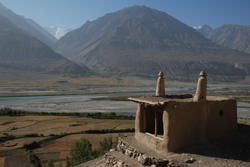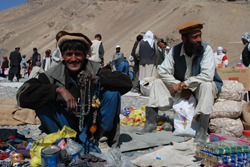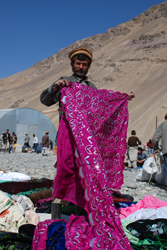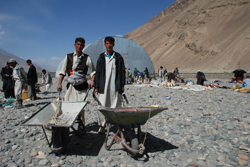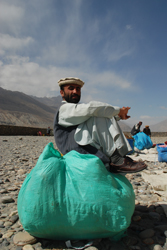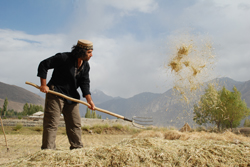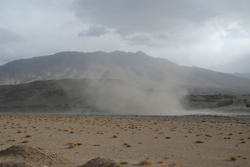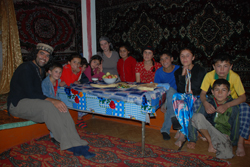Wakhan Trip Day 3: Spas, Stories and Sufis
21 September, 2008, 04:21 pm in "Tajikistan"
 The Khakha fortress ruins are perched on a rocky outcropping. From the road you see a few low stone walls with a melting coat of mud covering some. We followed a path up into the ruins. The walls surrounded a good amount of space. In one corner there were the remains of a round tower. Walking up to a higher level we could see a view of the river and mountains as well as a line of more intact walls.
The Khakha fortress ruins are perched on a rocky outcropping. From the road you see a few low stone walls with a melting coat of mud covering some. We followed a path up into the ruins. The walls surrounded a good amount of space. In one corner there were the remains of a round tower. Walking up to a higher level we could see a view of the river and mountains as well as a line of more intact walls.A little farther down the road was a shrine to Ali, the Prophet Muhammed's cousin and brother-in-law. The shrine was behind a wall with a beautifully carved door and room and ibex horns decorating the wall above it. We entered the area. Though the yard was large and full of trees, the shrine itself was small. The exterior had more beautiful carvings: columns, ceiling, and door. Above it there was a mountain goat head.
As we were looking at the shrine, a man named Aminbek, the custodian of the tomb, entered. He opened the shrine door and invited us in. Inside there was a simple stone block with 4 green painted stones set in the corners and one in the center with a pile of horns. Aminbek told us a local legend that Ali came to Khakha in the Wakhan Valley to fight the Mongols. There was a contest of strength and he juggled 5 heavy stones and then changed his horses shoes while galloping. After that he started wrestling with the enemy. They were defeated by his strength. Later, I found a more historical account of Islam coming to the Pamirs. It actually came much later, after the deaths of Ali and his sons. In looking at the tomb with its carvings of flowers, animal horns, rocks and setting surrounded by trees, it struck me how the Pamir Ismaeli version of Islam seems a a bit pagan in aesthetics. It makes me think of how Christianity blended with ancient beliefs of people in converted places leading to instances like in Haiti where the gods and goddesses were transformed into incarnations of Mary and the Saints. I wonder if at one point the shrine was an older sacred site.
There was a museum next to the tomb but it was closed and looked like it was under repair. Aminbek said they could send someone down the street to get the key but we decided to skip it. A little farther we stopped to take a look at another fortress ruins. We didn't go all the way up to it but to get a closer look we crossed through a field where people were busy harvesting wheat. After looking at the fortress, we went up to the group and said hi. We found out that one of the men harvesting was the director of the museum. He recommended some places for us to visit.
In a golden field near the road, a group of women wearing rose, red, and purple dresses were busy harvesting grain using small scythes. They mentioned a phrase we have often heard here: the harvest isn't good because there hasn't been enough rain.
In a golden field near the road, a group of women wearing rose, red, and purple dresses were busy harvesting grain using small scythes. They mentioned a phrase we have often heard here: the harvest isn't good because there hasn't been enough rain.
Outside the carefully cultivated villages, the landscape was stark: rocks and a perpetual haze of dust. The only brightness was when the pure white of the snow glistened on the massive peaks which shone from between the closer mountains. The Hindu Kush seemed to present a new glistening peak every few minutes of road. Some had scraps of clouds caught on their peaks. Others were cloudless but completely snow covered.
By this time the river had spread out into a braided rope with sand and mud flat islands between its skeins. There were some areas of dark green trees.
We turned up a gravel road into the hills to get to Yamchun fortress and the Bibi Fatima springs. I'm generally not a big fan of hot springs: hot sulfury smelly water, pumped into grimy pools or muddy smelly pits. The pools have ½ hour for women and then ½ hour for men.
I was very surprised to find a beautiful natural pool with green and white mineral formations. Gentle cascades of hot water spilled into the pool and there was no stinky sulfur smell. There was a group of women, girls, and one little boy in the pool. As I went into the pool a girl began talking to me in English. She guided me into the pool and sat me next to where some water was flowing in through a mineral formation. Light filtered from above and it was really quite enjoyable. She showed me a small cave in the rocks full of hot water and told me to make a wish and crawl in. I scraped my elbow as I crawled out.
By this time the river had spread out into a braided rope with sand and mud flat islands between its skeins. There were some areas of dark green trees.
We turned up a gravel road into the hills to get to Yamchun fortress and the Bibi Fatima springs. I'm generally not a big fan of hot springs: hot sulfury smelly water, pumped into grimy pools or muddy smelly pits. The pools have ½ hour for women and then ½ hour for men.
I was very surprised to find a beautiful natural pool with green and white mineral formations. Gentle cascades of hot water spilled into the pool and there was no stinky sulfur smell. There was a group of women, girls, and one little boy in the pool. As I went into the pool a girl began talking to me in English. She guided me into the pool and sat me next to where some water was flowing in through a mineral formation. Light filtered from above and it was really quite enjoyable. She showed me a small cave in the rocks full of hot water and told me to make a wish and crawl in. I scraped my elbow as I crawled out.
When the guys were finished, we drove back to the fortress. The fortress was a bit better preserved than the others we'd seen, probably because the stone walls had been built so thick-- some seemed more than 4 ft thick. The fortress commanded a view of Afghanistan mountains, the river, and villages below. Zaher pointed out some yurts: white dots on the Afghan side at the edge of a landslide. He said they were archaeologists who were excavating a village that had been buried by the landslide.
Our final stop of the day ended up being the village of Yamg which is a stop because it was the home of Sufi poet, musician, astronomer and mystic Mubarek i-Wakhani. We walked through town searching for the Mubarek i-Wakhani Museum, and found a building with its walls decorated with painted designs. Inside, we found some more buildings, all ornately decorated but with locked doors. One of the people outside the museum ran off to get someone with keys. Soon the director, Haydar, showed up and gave us a tour of the museum.
The first thing we saw was called a chilehane. It was a small windowless building where Sufis could go and spend 40 days just writing. It was a reconstruction. The chilehanes Mubarak Whakani used were often out in nature.
(Later I was able to look at a book written by Iloliev, about Mubarek's life as well as the spread of Ismaili Islam in the Pamirs so most of the historical information I'm mentioning comes from that.)
The museum is in a Parmir house, beautifully carved and painted inside. It isn't the original house of Mubarek though I believe it is in the same location. It took 7 years to finish and many people of the village worked on it.
The first thing we saw was called a chilehane. It was a small windowless building where Sufis could go and spend 40 days just writing. It was a reconstruction. The chilehanes Mubarak Whakani used were often out in nature.
(Later I was able to look at a book written by Iloliev, about Mubarek's life as well as the spread of Ismaili Islam in the Pamirs so most of the historical information I'm mentioning comes from that.)
The museum is in a Parmir house, beautifully carved and painted inside. It isn't the original house of Mubarek though I believe it is in the same location. It took 7 years to finish and many people of the village worked on it.
The first room contained ethnographic everyday items like those that would have been used by Mubarek to make his own clothing, paper, carved wood and other practical items. These had been donated by people in the village as well.
There were some interesting rababs which were copies of a type of rabab invented by Mubarek called the “Baland-maqam” (highest state) which Mubarak played when meditating on what he felt were highest thoughts. It has 19 strings and Haydar later explained the significance of its construction: the body is made from apricot wood cut in spring when it was in flower because they say the tears of the apricot tree become the flower. Also it is thought that the flower sees the world since it is the young stage. The fruit is the final stage and has experience like a mature human. The strings are made from the gut of a lamb so when you play, you hear the sadness and cries of the lamb. The skin is from a foal so when you play, you hear the cries of the foal. The instrument from the back, resembles a human with head, arms, body and feet. The philosophy is that when you play, the cries of your heart and soul become music.
Outside in a field behind the museum is the solar calendar. It consisted of a stone with a round hole in it called the Observation stone (Sang-i-aftab-bin), through which you looked and observed where the sun set in relation to a stone window on the hill above and to the West, the Sign Post Stone (Sang-i-Nishan). On Nowruz, the first day of spring, a crescent of the sun could be seen through the signpost stone. If a full circle was seen, it was foretold. The year would be good. There were 2 stone pillars on the hill which were used in case of clouds on Nowruz. Then measurements could be taken using the pillar stones the day before and day after. Mubarek's tomb is near the signpost stones and with 2 stone pillars on top looks like it could be some kind of astronomical observation tool itself.
We decided to spend the night in Yamg and Haydar said tourists usually stay at his house. He took us to his house and we were delighted to see the table was already set with plates holding tomatoes and onions, bread, tea, and snacks. When he was told there were visitors at the museum, he had his family get tea ready for us. We were all famished since we hadn't stopped for lunch. We were served tea and then he asked if we wanted dinner which was also already prepared. We had a fine meal of soup and fried potatoes, onions and carrots.
As the sun set the wind picked up rushing through the valley and wailing over the roof of the house.
As the sun set the wind picked up rushing through the valley and wailing over the roof of the house.
[ View 1 Comments
|
]
Wakhan Trip Day 2: Visiting Afghanistan
20 September, 2008, 08:22 am in "Tajikistan"
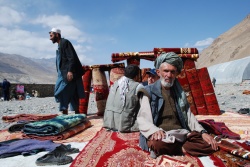 We were talking to a couple who had been talking to a travel agent about visiting Afghanistan. They were told that if they had gone 6 months (or was it 6 weeks) before, it would have been fine. But now it was terribly dangerous. They were told about how there are organized kidnapping groups who record the movement of foreigners so they can be intercepted and taken hostage. The travel company then said if they really really had to go to Afghanistan or were adrenalin junkies, if he spent the next month growing a beard and she wore a burka, the company could arrange, through various connections, so the couple could be smuggled from safe house to safe house and thereby tour Afghanistan. The couple said that their idea of travel was being able to talk to people so they decided against this option.
We were talking to a couple who had been talking to a travel agent about visiting Afghanistan. They were told that if they had gone 6 months (or was it 6 weeks) before, it would have been fine. But now it was terribly dangerous. They were told about how there are organized kidnapping groups who record the movement of foreigners so they can be intercepted and taken hostage. The travel company then said if they really really had to go to Afghanistan or were adrenalin junkies, if he spent the next month growing a beard and she wore a burka, the company could arrange, through various connections, so the couple could be smuggled from safe house to safe house and thereby tour Afghanistan. The couple said that their idea of travel was being able to talk to people so they decided against this option. Today we went to Afghanistan, or at least as close as we're going to get. All the tourists come to Ishkashim on Saturday to be able to cross the bridge to Afghanistan and go to the Afghan market. We left around 8 to walk 3 km to the edge of town where the bridge is located. From a distance we could see rows of cars parked and a line of people converging on the market site from both Afghanistan and Tajikistan. The Afghan side of Ishkashim is called Ishkashim Sultan because it used to be the main part of the town before it was divided between the two countries.
On the Tajikistan side of the bridge there is a metal gate lined with barbed wire and maned by Tajik soldiers and police. The soldiers kept the gates open just wide enough for one person to pass through, though they would open it wider when necessary. The Tajiks just walked through with no questions but tourists had to relinquish their passports and GBAO permits. I guess it was assurance that we wouldn't attempt to run of into Afghanistan. The first thing the soldiers said, in both Tajik and Russian to both Rowshan and me, was that photos were strictly forbidden. This was particularly disappointing because that was what Rowshan really wanted to do at the market. The market was located in no-man's land, an area of sand and river stones, surrounded by a stone wall with a metal gate. The vendors set up their wares on tarps on the ground.
It wasn't the most exotic of markets we've been to. Most of the wares were things of interest to Tajiks and Afghanis-- toiletries, women and men's clothing, sewing machines, candy, jewelry, CDs, VCDs, DVDs, cassettes, fabrics, and shoes.
We also saw strange pointed stones that had been carved into a bullet sized pencil shape. Some had jewels attached. Later we learned they were for applying kohl. We were disappointed to find no Afghan food. The most interesting Afghan clothing was being worn by vendors. Rowshan was searching for an Afghan man's outfit-- long loose light shirt and baggy pants. He found some that seemed factory made with stiff western collars. Eventually he found one that was softer without a stiff collar which he purchased. He asked about the turban traditionally worn with it. No one had one among their wares but a couple vendors offered to sell the ones they were wearing. On one side we saw a couple fortune tellers. One used a Hafez book to foretell the future. There were a couple people selling traditional Afghan wool hats but we decided these were too hot for where we were going. There were also a few spice and herb sellers but not enough to give the place an exotic smell.
As we were chatting with some kids, a police officer came out of the guest house and informed us we had to register. We asked at the guest house and learned that a few months ago, a shepherd had attacked a tourist. Now the police wanted all visitors to register for their own protection. So we walked over to the police station. The police explained that by registering with them they were taking responsibility for our safety. They were very friendly and asked how Rowshan liked it here. He said he liked it and enjoyed the bazaar but was disappointed that he wasn't allowed to take photos. “What? They wouldn't let you take photos? They'll let you. Just 'talk nicely' to them.” It was around noon and we had 2 hours before the market finished. We hopped into a taxi and went back to the bridge.
At the gate, Rowshan was told “No” by several soldiers, police and a commanding officer. But he hung out and talked...and talked... for about ½ hour. Finally they let him in to “Just take 2 photos of guys in Afghan clothing.” None of the many soldiers and police patrolling the market even questioned him as he took photos. I worried that after all the effort to be allowed to take photos, the Afghan vendors would be unwilling to have their photos taken. The men seemed sun and wind-weathered and tough. I imagined them getting angry at Rowshan. My worries were completely unfounded. Everyone Rowshan asked was delighted to have him take their photo. One man at first said “no” but after seeing his neighboring vendor pose, he relented and wanted a photo taken as well. Cloth vendors posed with sparkling fabrics.
At the gate, Rowshan was told “No” by several soldiers, police and a commanding officer. But he hung out and talked...and talked... for about ½ hour. Finally they let him in to “Just take 2 photos of guys in Afghan clothing.” None of the many soldiers and police patrolling the market even questioned him as he took photos. I worried that after all the effort to be allowed to take photos, the Afghan vendors would be unwilling to have their photos taken. The men seemed sun and wind-weathered and tough. I imagined them getting angry at Rowshan. My worries were completely unfounded. Everyone Rowshan asked was delighted to have him take their photo. One man at first said “no” but after seeing his neighboring vendor pose, he relented and wanted a photo taken as well. Cloth vendors posed with sparkling fabrics.
Some grabbed their friends or relatives. The photography turned out to be a bit of an ice breaker so soon they were all happily chatting with Rowshan. Many had worked in Iran and lived in Tehran. They drew out words of Tehrani slang and names of neighborhoods.
Maybe since the market was winding down, people were more social as well. The vendors chatted with each other as they packed up their wares. Porters hauled huge loads out of the market and occasionally a cart was wheeled out.
[ View 1 Comments
|
]
Wakhan Trip Day 1: Khorog to Ishkashim
19 September, 2008, 07:59 am in "Tajikistan"

The road to Ishkashim follows the Pyanj River and the Afghan border south. From the car, we looked across the sage colored river at the mountains and the Afghan villages at their feet. The villages were mostly walled fields with a few adobe covered stone houses. The predominant feature of their houses were huge towers of hay on their roofs.
On both sides of the river, villages gently rose up the lower parts of the slopes. People were threshing wheat using oxen or winnowing by throwing pitchfork loads of straw into the air.
Our driver, Zaher, explained how the Pamirs were divided with half in Tajikistan and half in Afghanistan. This caused families to be divided. Aga Kahn was helping to build bridges to connect the 2 sides. Aga Kahn started helping the region in 1993 when food production had been disrupted due to droughts and the Civil War. For the first 4-6 years, he provided food aid to the region. Then he started other projects like building schools and bridges. The Aga Kahn Development Network is also helping to develop industries like agricultural processing and community-based tourism in the Pamirs. They are also funding road building on the Afghan side. Zaher pointed out some places where they had started blasting rocks to make space for it.
In an especially serene valley called Kazideh, we stopped so Rowshan could take a photo of a man winnowing. Two women and their children carrying huge bundles of hay passed by.
Our driver, Zaher, explained how the Pamirs were divided with half in Tajikistan and half in Afghanistan. This caused families to be divided. Aga Kahn was helping to build bridges to connect the 2 sides. Aga Kahn started helping the region in 1993 when food production had been disrupted due to droughts and the Civil War. For the first 4-6 years, he provided food aid to the region. Then he started other projects like building schools and bridges. The Aga Kahn Development Network is also helping to develop industries like agricultural processing and community-based tourism in the Pamirs. They are also funding road building on the Afghan side. Zaher pointed out some places where they had started blasting rocks to make space for it.
In an especially serene valley called Kazideh, we stopped so Rowshan could take a photo of a man winnowing. Two women and their children carrying huge bundles of hay passed by.
As we got closer to Ishakashim, the graceful white peaks of the Hindu Kush became visible. People in the village were busy with the wheat harvest. We saw a man threshing with a team of donkeys. Later, when we walked by again, they had started winnowing. Rowshan got a lesson and helped out a little.
On the street, a girl came up and said, “hello.” To our surprise, she continued with several more phrases in English, and when we responded, was able to continue the conversation beyond, “Where are you from?” and “What is your name?” She had been teaching herself English and had apparently seized the opportunities for practice offered by tourists staying at the neighboring guest house.
Her name was Nasibe and though she was only 12, spoke more English than most adults we've met. She asked to walk with us and we were soon joined by a friend of hers nick-named “Jimmy.”
They offered to show us a cave where people had lived in old times and during the war. It was up the road a bit. The wind was picking up and sent clouds of dusts and dust devils through the empty fields where the wheat had already been harvested. The Afghan side looked even drier with huge spinning dust devils looking like obscured water falls.
We climbed up the scree of a slope to the first cave, a tall, smoke blackened hole in the mountain. A small rock wall had been built in front, maybe to keep people out but if so, not very effectively. We found a scary cave monster there.
Her name was Nasibe and though she was only 12, spoke more English than most adults we've met. She asked to walk with us and we were soon joined by a friend of hers nick-named “Jimmy.”
They offered to show us a cave where people had lived in old times and during the war. It was up the road a bit. The wind was picking up and sent clouds of dusts and dust devils through the empty fields where the wheat had already been harvested. The Afghan side looked even drier with huge spinning dust devils looking like obscured water falls.
We climbed up the scree of a slope to the first cave, a tall, smoke blackened hole in the mountain. A small rock wall had been built in front, maybe to keep people out but if so, not very effectively. We found a scary cave monster there.
Inside, the cave was dark, blackened with smoke and a bit smelly. The cave did, however, have a great view over the river to the mountains of Afghanistan.
We climbed further up the hill to a second cave. This one was less obvious because the entrance was set partially underground. To one side a stone structure of a few walls had been built. Where the first cave was blackened with smoke, the inside of the 2nd cave was white with mineral deposits. People in town would collect it to use to white wash their houses. Touching the low ceilings of the cave produced a handful of white powder.
We climbed back down to the black cave (Torge Soxte- Burnt Cave) and Nasibe broke off pieces from a rock producing interesting green colored stone and rose colored mica. We took a closer look at the stones that made up the hill and realized, beneath the coat of brown dust and dried mud was some beautifully colored rock. I wondered if after a heavy rain, the mountains sparkle with green, red and rose. We climbed back down and walked towards the town. The evening winds were picking up huge dust clouds. I understood why so many women wear their scarves wrapped around nose and mouth.
We climbed further up the hill to a second cave. This one was less obvious because the entrance was set partially underground. To one side a stone structure of a few walls had been built. Where the first cave was blackened with smoke, the inside of the 2nd cave was white with mineral deposits. People in town would collect it to use to white wash their houses. Touching the low ceilings of the cave produced a handful of white powder.
We climbed back down to the black cave (Torge Soxte- Burnt Cave) and Nasibe broke off pieces from a rock producing interesting green colored stone and rose colored mica. We took a closer look at the stones that made up the hill and realized, beneath the coat of brown dust and dried mud was some beautifully colored rock. I wondered if after a heavy rain, the mountains sparkle with green, red and rose. We climbed back down and walked towards the town. The evening winds were picking up huge dust clouds. I understood why so many women wear their scarves wrapped around nose and mouth.
By the winnowing field, Rowshan stopped and chatted with a group of people having tea. Then we went to Jimmy's house for some tea. Jimmy's house was a large comfortable Pamiri house. We had been joined by quite a group of kids who hung out watching as we had our tea.
On the way back to the guest house, we passed a soccer game. Soon Rowshan was playing and managed to score a goal. While he played, I talked to a couple girls in Russian.
[ View 2 Comments
|
]




